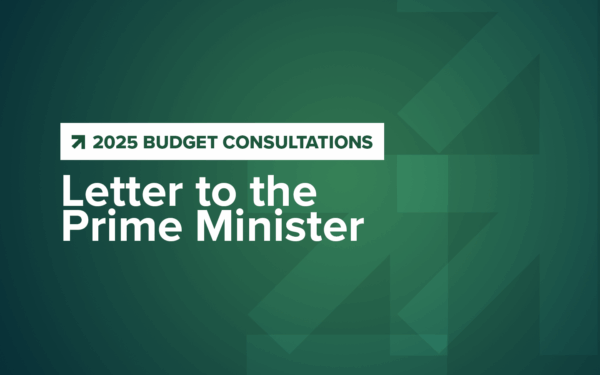Kananaskis 2011: building an agenda for a sound energy future
Submission to the Conference of Energy and Mines Ministers
The Canadian Council of Chief Executives, together with a growing chorus of governments, business organizations and research institutions, have made the case that Canada’s diverse array of energy resources, plus the skill and technologies to develop them, are some of Canada’s greatest sources of comparative advantage and key drivers of our future prosperity. Canada is very well placed to be a leader in the global transition to cleaner energy and advanced technologies that can deliver superior energy services with much less environmental impact.
In addition to traditional fuels and technologies, Canada is blessed with stockpiles and opportunities in low and non‐carbon fuels – hydro, nuclear, wind, solar and geothermal, advanced biofuels, shale gas – as well as new transportation technologies such as electric, hydrogen and other alternative fuel vehicles. No doubt, carbon‐based fuels will be with us for some time to come, but there are significant opportunities to improve their efficiency and effectiveness and technology has the potential to greatly reduce their environmental footprint.
As we pointed out in our Clean Growth 2.0 paper1, this opportunity brings significant national benefits – economic growth, jobs, training, research and new technologies, not to mention additional revenues to all three levels of government. Significantly, these benefits flow to Canadians from coast to coast, not just to those in regions with the largest energy resources. But that future is not guaranteed; smart policy and private sector commitment and innovation are required to spur the necessary investment and realize the benefits for Canadian citizens. It also is critical that we do a better job of demonstrating to the world that Canada can be a reliable partner, a source of sound energy to meet other countries’ needs while also employing advanced environmental practices.
There has been much discussion in recent months about the need for a “national strategy” on energy. Whatever the label, we see this not as a single document but rather more of a vision, a broad framework and set of criteria against which to test existing and future policy. Indeed, the engagement of a wide range of players in this debate has shown that there is no lack of ideas on how to strengthen Canada’s energy advantage.
What is needed is focus, discipline and follow‐through.
To give shape to this growing consensus, federal and provincial governments should agree on a broad vision and key priorities. The CCCE and business leaders across the country stand ready to engage with governments and committed stakeholders to help shape the longer‐term transition to cleaner and more efficient energy production and consumption. While thinking about this broader framework, it is equally important to establish some immediate and tangible steps that will build momentum around the longer‐term game plan.
Federal and provincial energy ministers agreed at their 2010 meeting on the need for greater “pan‐Canadian collaboration” on energy policy. Their upcoming meeting in Kananaskis is the perfect time to put that commitment into action.
Market‐based Energy Policy
For Canada, energy policy starts with a commitment to the market‐based policy framework that has served us well for many decades. We are and should remain governed by fundamental economic principles in an era when more and more energy around the world is under government ownership or state‐supervised control. Among other things, this is the best means to ensure that Canada can enjoy competitive energy pricing which has been key to the success of Canada’s most energy‐intensive sectors.
All forms of energy will be required to meet growing demand, both in Canada and internationally, and the market should be the primary determinant of which resources are developed and what kind of infrastructure is built to carry them. But that is not to say that there is no place for some degree of government involvement where it may be the key ingredient to help to unlock regional energy potential.
Due to Canada’s diverse mix of energy resources, some regions are more heavily weighted to oil, gas and coal, while others have considerable assets in hydroelectricity and the opportunity to expand renewable sources of energy. To truly realize Canada’s potential and ensure energy development can benefit all regions, we should consider the need for targeted and modest government support to expand renewable and lower‐carbon energy potential in a few key regions. In the recent election campaign, the Prime Minister pledged to consider loan guarantees to help realize expansion of hydroelectricity on the Lower Churchill. Given the tremendous energy potential that we possess, this just might be the nation building exercise of the 21st Century.
Diversifying Energy Markets
At present, virtually all of the Canada’s energy exports are destined for the United States. Needless to say, this continues to be an enormous economic benefit to Canada. There are increasing signs that the United States wants greater control over its energy destiny and Canada is a friendly, stable supplier with existing cross‐border supply networks and a market‐based energy policy. Recently, we have witnessed delays in several major infrastructure projects, for instance the Keystone XL pipeline. The Canadian government needs to work closely with the United States to speed and simplify regulatory processes and develop joint energy policies to ensure that projects of vital importance to both countries proceed in a rational, market‐driven manner.
Canada’s vast array of resources also can benefit other parts of the world which need energy to power their prosperity, particularly the rapidly growing economies of the Asia‐Pacific. The US market will always remain important to Canada, in energy and a wide range of other goods and services. At the same time, it is readily apparent that Canada should be putting in place the enabling infrastructure and supportive policy environment to take advantage of growing global energy markets. We must look to maximize the potential of our diverse energy resources, as well as the opportunity to develop and adapt advanced technologies and energy services, and the skilled jobs and value‐added businesses that go along with them.
The development of new energy sources and the resultant infrastructure must of course meet all applicable regulatory requirements. Canadian firms also must continue to pursue best practices in terms of project management, community outreach, safety and environmental responsibility. This is essential if we are to build Canada’s brand as a sound developer of energy. But it is particularly important that we avoid artificial impediments to Canada’s export potential, such as a ban on tanker traffic on the West Coast.
Enhancing Energy Conservation and Efficiency
As we stated in our Clean Growth 2.0 paper, a first priority of any energy strategy must be to instill a culture of conservation among Canadians and to ensure we are using every opportunity to maximize the potential of energy efficiency. We do not underestimate the scale of this challenge, but we need to look at more innovative ways that governments, the private sector and other contributors can participate in a sustained effort on energy education. Canadians should be more actively engaged in an informed discussion about Canada’s energy future and they need better information about the costs and benefits of particular energy choices, and about smarter choices they can make in day‐to‐day energy use.
Government programs should be carefully reviewed to ensure they are promoting the most efficient use of energy. The focus should be on practical measures grounded in least cost for a given environmental result and that can build support for the longer‐term transition that is needed. Strengthened government/industry partnerships will be critical to realizing necessary gains in industrial energy efficiency. We also need to look at ways to enhance infrastructure supporting biomass and other low‐carbon energy sources, as well as the refueling infrastructure for alternative transportation fuels.
Canada’s energy efficiency potential and facilitating the expansion of lower‐carbon energy sources can only be realized with a modern electricity infrastructure. With increasing electricity demand, the need to replace or refurbish existing generation facilities and the reality of aging transmission systems, the Conference Board of Canada has estimated that close to $300 billion of investment in electricity infrastructure will be needed between 2010 and 2030.2 Undoubtedly, that will require more private capital and we should be exploring the potential for public‐private partnerships on generation and transmission infrastructure.
It also means that that our provincial governments should be enhancing regional electricity grids. By that we do not mean some idealized cross‐country, East‐West grid. Rather, greater effort needs to be focused on the potential for select regional interconnection, driven by practical economics and the opportunity to increase access to renewable energy for regions dominated by high‐carbon fuels.
Regulatory Efficiency
Many projects to increase Canada’s energy diversity may go wanting if we cannot improve the timeliness and efficiency of approval processes needed to get those projects committed and financed. As well, there are many opportunities to realize economic benefit from existing energy resources that may be delayed or abandoned if delays or excess cost put Canada at a disadvantage to investment opportunities in other countries.
Significant effort has been expended in recent years, by both governments and the private sector, to come to grips with this issue. And yet, there are still far too many cases of conflicting jurisdiction, either between different departments of the same level of government or between levels of government, overlap and duplication in regulatory requirements, and unnecessary delay in getting final approval.
This is clearly one area where meaningful progress is overdue and governments should commit to a reinvigorated federal‐provincial‐territorial framework for timely assessment of major energy projects.
This would include:
- A guiding principle of one project, one assessment;
- Identification of a lead agency in each jurisdiction;
- A commitment to class approvals for major project types;
- The ability to accept assessment/approvals undertaken by a comparable regulator in another Canadian jurisdiction;
- Clear timelines for decision‐making; and
- A single place for deposit of data, information and analysis.
Innovation and Technology
As a country, we need to be a builder and developer of smart energy solutions, not just a receiver and adapter of other people’s ideas. We already have significant potential in a number of key energy technologies and governments should collaborate to clarify and strengthen the policy environment that will incent technology development and deployment. A key element is to foster greater collaboration amongst industry, government labs and academic research, both to further fundamental R&D and to ensure that more innovative ideas can make it to commercialization and eventually successful businesses.
Fossil fuels will still be part of the mix for some years to come, and we need to do better on improving oilsands extraction and generally getting more energy value out of our stock of conventional energy with less environmental impact. We also should investigate the country’s potential for advanced technologies that can further development of low impact, high value energy.
We see two important areas for further collaboration between the private and public sectors in stimulating technology development and deployment. The first would be in considering means to cost‐share demonstration projects of near‐commercial technologies. Second, governments could develop a national private‐public partnership to help fund promising technologies. A relevant model is the Climate Change and Emissions Management Corporation in Alberta, an independent agency that invests in promising technology opportunities in the province, using the funds paid by Alberta’s largest GHG emitters to meet their regulated emissions obligations.
A similar national organization could begin with start‐up funding from both levels of governments, but transition to funding primarily from a portion of the revenue raised by a national carbon pricing scheme. It should have an arms‐length decision‐making body with a mandate for regional and technology balance, but also a focus on the likely cost‐effectiveness of specific technologies. Critically important will be to ensure that any funding provided through this vehicle acts primarily to leverage significant additional investment from private sector partners.
National Approach to Climate Policy
It should be readily apparent that Canada is not well served by the current patchwork of differing federal and provincial climate change targets and often conflicting policies and timelines. In an era when rhetoric and lofty promises have exceeded actual performance, governments should commit to climate and environmental policy that is enlightened yet pragmatic, that sets reasonable objectives in the near term, makes steady progress over the medium term and lays the groundwork for the longer‐term transition to lower‐carbon energy. We acknowledge that this is not the direct purview of energy ministers. Yet a comprehensive and effective energy strategy cannot be fashioned without addressing this important component in an integrated fashion.
The CCCE has previously stated its support for a broad‐based carbon pricing scheme in Canada.3 Carbon pricing can be a primary means, whereby Canadians – as business owners, farmers, building managers and individual consumers – see the everyday cost of inefficient use of energy and are motivated to change their energy consumption patterns as well as their investment and buying decisions.
We stand ready to work with the federal and provincial governments on a broadly‐based carbon pricing scheme that is transparent and predictable, that asks for appropriate efforts from all sectors of the economy and all regions of the country, that is closely aligned with that of our major trading partners, particularly the United States, that drives necessary changes in behaviour, and that can be a spur to innovation and the development of less GHG‐intensive energy sources, products and services.
Five Priorities for Ministers
In summary, we believe federal, provincial and territorial energy ministers have a critical opportunity in Kananaskis to set a dynamic course for the country. Five priority elements are needed:
- Outline a vision of one national approach to energy that maintains our commitment to market principles and seeks to maximize the opportunity inherent in the country’s incredible diversity of energy resources.
- In concert with the private sector, develop a policy framework that can preserve and enhance Canada’s access to US markets and also take advantage of emerging opportunities to export our energy, advanced technologies and expertise beyond North America.
- Go beyond the oft‐repeated words of regulatory harmonization, commit to “one project, one assessment” and instruct your respective departments to make it happen.
- Develop a policy framework that spurs better public‐private collaboration on energy technology and enables Canadian firms to effectively compete as suppliers of leading‐edge energy technologies and services.
- Commit to a pan‐Canadian climate change policy that is enlightened yet pragmatic, and that makes reasonable and steady progress now while preparing the country for the longer‐term transition to lower‐carbon energy.










